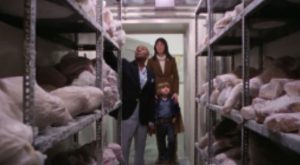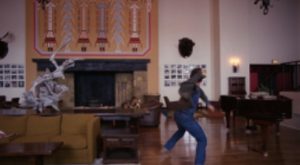14 The Shining (1980)
A Flawed Masterpiece: Difference and Oppression in Kubrick’s The Shining
By Jacque Higley
Imagine a scenario where you are in the mountains, isolated and trapped, something dark and menacing brimming on the horizon, but you can’t quite see it, only your family and the cold of winter surround you. The Torrance family does not have to imagine this scenario, as it is the grim reality they are faced with. Stanley Kubrick’s notorious 1980 classic thriller gives you everything you could want from a hotel horror film and more. The Shining is arguably one of Kubrick’s most famous films to date, with millions of fans and critics worldwide. The Shining follows the Torrance family, Jack, Wendy, and their son Danny, as they navigate the sinister challenges of being winter caretakers at the remote and haunted Overlook Hotel. Jack takes the caretaker position in hope of finding a fresh start, aiming to work on his book, he tries to put his old life of alcoholism and violence behind him. The film takes a dark turn as visions of the hotel’s past and ghosts of the present plague Jack and his family. As Jack begins to mentally unravel, we see the effect that cabin fever, in combination with ghostly visions, can have on a person’s psyche and their family.
This film explores several different motifs throughout the course of its run time, utilizing literary design and mise en scène to successfully deliver its message to the audience. The Shining both directly and indirectly tells the story of oppressed people succumbing to situations outside of their control. In short, this is a film about the evils and abuse that stem from a white patriarchal society. Themes of racism, traditional gender roles, domestic violence, and oppression of native people through colonization are told to the audience through different mediums in a way where everyone can take away something different from the story. The Shining effectively represents themes of difference, power, and oppression through dramatic literary and visual design as well as calculated cinematography.
As our film sets up we meet the fourth and only main character who is not a part of the Torrance family, Dick Hallorann. Dick is a successful black man and head chef at The Overlook Hotel, played by Scatman Crothers, Mr. Hallorann quickly bonds with Danny as they find out they both have the ability to “shine”. Communicating with each other telepathically, Hallorann explains to Danny that being able to “shine” is a rare supernatural ability, a clairvoyance that allows people to see or hear things out of the ordinary. Later in our film as Jack spirals into mad violence a terrified Danny uses his ability to shine to contact the now multiple states away Dick Hallorann. Danny telepathically lets Hallorann know something is wrong at the hotel, and they need urgent help. Meanwhile, Jack is spiraling further, conversing with the ghost of a past caretaker in one of the hotel bathrooms. Jack is informed by the entity that his son has called for help, specifically help from a black man. In this scene, the N-word is used 3 times, said by both white characters. This scene emphasizes that not only is outside help a problem, but a black man being the opposition is an even bigger problem. Jack is told that his son Danny and wife Wendy must be “corrected” due to this behavior. Near the end of our film, Jack has finally engaged in his murderous frenzy and all madness has taken over, it is at this point Dick Hallorann finally makes it up the mountain to the hotel. In true 80s horror fashion, our black character never makes it out alive. Hallorann is quickly killed by Jack and his murderous axe. It is important to note in the original book by Stephen King that Jack badly wounded Hallorann, but he does survive. However, Hollywood has a past of being unkind to people of color, which was especially true during the 1980s. Black actors and actresses were often given supporting roles over leads, supporting roles normally equate to a dying role as seen in this instance.

Despite the unfair differences many black actors and actresses face in the film world, The Shining does a few things differently from other films from the era. Hollywood loves to play into the trope of the white hero/savior, but in this film, Dick Hallorann is called in to be the hero of the story. Danny reaches out to Hallorann because he feels safe with him and Danny knows he will travel up the snow-covered mountain to save him and his mother. The relationship between Danny and Hallorann is a pure one; at that time, their friendship reflected the new generation being raised, feeling the effects of the civil rights movement. In this midst of civil reform, children were no longer taught to segregate, and racist traditions no longer defined America. Clever visual design is utilized to hint at this idea when Danny and Dick Hallorann meet. Danny is wearing a red, white, and blue shirt that displays the number 42 on the sleeve, the number of Jackie Robinson, who broke the color barrier many years prior. This film also portrays Hallorann as a very successful well adjusted man who is liked by everyone. Immensely positive traits like these are not commonly seen in supporting black characters. As author Kyra McKauffley states, “Hallorann, with his professional success and personal life satisfaction, starkly contrasts with Jack, who struggles on both fronts” (4). This further proves that the blueprint of the white savior and strong white patriarch is not followed in this film, as they so commonly are in other movies from this time.
A scene I found interesting while analyzing themes of race and gender roles in The Shining takes place in the walk-in freezer while Dick Hallorann is giving the initial tour of the hotel kitchen to Wendy and Danny. Hallorann is told to give Wendy a tour of the kitchen as she is the traditional homemaker in this film thus, she will be the one cooking and cleaning. Danny follows behind as Wendy is also in charge of the child-rearing. As they tour the kitchen, Hallorann and Wendy are arranged together to show their lower status when compared to Jack, who at the same time is touring the hotel with the owner, illustrating his status as a white man. The shot of Hallorann and Wendy hints that women and people of color are seen as subordinate when compared to the white man. This tracking shot is utilized while Wendy, Danny, and Halloran tour the kitchen. The tracking shot creates the idea of continuity and focuses on all three of these characters at once; this suggests they are equal as we view them all as one collective, subordinate group. However, when they step into the walk-in freezer, the tracking shot ends, and racial inequality is now seen in the way in which the characters are shown in the scene. Hallorann steps down while Wendy and Danny stay on the top step. This picture shows the racial dominance of white over black, despite the fact that Wendy is female and Danny a child, making all three characters subordinate to the white patriarch. This placement of characters illustrates that there are different levels of subordination among the group.

Aside from some glaring racist ideology pushed in this storyline, there is an obvious theme of the oppression of women, domestic abuse, and how traditional gender roles contribute to those things. This movie’s perspective from the get-go is that women belong in the home as a domestic mother and wife. Our first introduction to Wendy is a scene where she and Danny are seated at home around the kitchen table establishing them within the realm of domesticity as their roles would suggest as child and mother, this is again echoed several scenes later when Wendy is sent with Danny to tour the kitchen in the hotel with Mr. Halloran. Contrarily, the first scene when we meet Jack shows him in an office interviewing to be the caretaker for the hotel, surrounded by other white men with powerful roles. Throughout the rest of the movie, we watch Wendy tend to both Jack and Danny, keeping up with the domestic chores of cleaning and cooking. Sequentially, she ends up taking on the role of caretaker to both her family and the hotel itself when Jack fails to keep up with his duties. Wendy’s anxiety about failing her traditional gender role as a mother and wife is a key element in the film’s exploration of the oppression of women within a nuclear family structure. This film also explores how the nuclear family’s gender roles reinforce authority from the patriarchy at the expense of a female. The societal expectation of the man is to be headstrong and aggressive, which in turn limits his range of acceptable behaviors, further proving how these unrealistic expectations are harming their ability to express emotion or convey weakness. In the example of Jack, these emotions are repressed by shame or simply manifested through violence, sexual frustration, anger, and resentment towards his son and wife. When referring back to the scene of Jack in the bathroom with the ghost of the past caretaker author Delia Konzett notes, “The scene, it can be argued, frames the film in the discourse of troubled race and gender relations in the wake of 1960s civil rights legislation and second wave feminism of the 60s and 70s. Whiteness and masculinity in the film are therefore placed under duress and struggle to assert their traditional authority” (153).
Along with the oppression of women, themes of colonization and living on stolen land from native people prevail heavily through the story and cinematography of The Shining. As the story begins to build the world up around it the audience is quickly informed by the hotel owner that “The site is supposed to be located on an Indian burial ground and I believe they actually had to repel a few Indian attacks as they were building it.” (00:23:37 Kubrick). The first obvious example of oppression is the fact that colonizers stole native peoples land then decorated the main lobby of the hotel in whitewashed Navajo and Apache motifs. The visual design of this film shows patterns used within the hotel, both in the art and furniture, that are Native American designs, even if not specifically acknowledged as so. This is a demonstration that not only have we taken their land, but we have also swallowed their culture. These connections are symbolic are undoubtedly intentional as the killings that take place at The Overlook Hotel can be interpreted to represent the historical genocide of Native Indians, where Jack seems to represent the culprit of these transgressions. This film is clearly about the United States’ inability to acknowledge the genocide of Native peoples, or better stated, America’s ability to “overlook” genocide. Even the last scene of the film references the 4th of July Ball, which has obvious meaning due to one of the key scenes taking place at this Independence Day celebration, that date especially having relevance to Native Americans.

It is easy to tear down a film, finding flaws in any piece of media is easier and quicker to do than giving it praise. Despite the negative themes of difference, power, and oppression, The Shining by Stanley Kubrick is actually a very entertaining and well-made film with incredible cinematography. As a product of the 80s, themes of racism and traditional gender roles were much more commonly talked about and accepted, while this is no excuse, it is important to be aware of the context and time period from which a piece of media was produced. The Shining has its flaws like every movie, but this film will forever hold a special place in my heart, mind, and history.
References
McKauffley, Kyra. “The Shining as a Response to Cultural Racism.” Liberated Arts: A Journal for Undergraduate Research, 2023, ojs.lib.uwo.ca/index.php/lajur/article/view/15712.
Konzett, Delia. “Kubrick’s Red Room: Architecture, Race, and Nationhood in The Shining.” Quarterly Review of Film and Video, Routledge Taylor & Francis, 2022, research-ebsco-com.oregonstate.idm.oclc.org/c/u4nmuo/viewer/pdf/fqu2dj4w2j?route=details.
Kubrick, Stanley. The Shining. Warner Bros., 1980.

